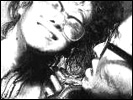Tetsuo: The Iron Man
- Year
- 1989
- Original title
- Tetsuo
- Japanese title
- 鉄男
- Director
- Cast
- Running time
- 67 minutes
- Published
- 8 August 2001



by Tom Mes
At the end of the 1980s, when mainstream Japanese cinema was dead in the water and the decade's one original filmmaker, Sogo Ishii, was going through a creative crisis, along came a grainy, black & white 16 mm film that wiped the floor with anything made in Japan for several years.
Shinya Tsukamoto's Tetsuo: The Iron Man was a relentlessly energetic film made at a time when the energy had all but disappeared from Japanese film. The culmination of a decade's worth of amateur short filmmaking and the crowning achievement on the activities of a private, experimental theatre group, Tetsuo had all the characteristics of unbridled zeal and amateur enthusiasm, and all the signs of true filmmaking talent.
Revolving around the transformation of people into grotesque hybrids of flesh and metal, Tetsuo is above all an overwhelming audiovisual experience, set to a brain-pounding score by Chu Ishikawa and complemented by suitably exaggerated sound effects. David Lynch's Eraserhead has often been mentioned as an influence because of its similar brooding, black and white images, but the film's visual language most likely originated elsewhere. The film's triumphant use of camerawork and editing are clear continuations of the style pioneered by Sogo Ishii, taking both to an even higher level of intensity than that on display in Ishii's seminal Crazy Thunder Road (Kuruizaki Sanda Rodo, 1980) and Burst City (Bakuretsu Toshi, 1982), while the use of stop-motion recalls the scrap animations of Jan Svankmayer. Composition and lighting, especially the expressionistic close-ups, echo classic Japanese horror films such as Throne of Blood (Kumonosu-jo, 1957 - Akira Kurosawa), Kwaidan (Kaidan, 1964 - Masaki Kobayashi), and Onibaba (1965 - Kaneto Shindo). At the center of it all, actors move as if they were performers in a modern dance piece, belying the participants' origins in experimental theatre.
The influences don't stop there. The design of the iron man combines elements from the work of artist H.R. Giger, the aforementioned Jan Svankmayer as well as Japan's own kaiju films. The comparison to Godzilla and company is not just a visual one. The theme of mutation which lies at the heart of the big monster movies (particularly Ishiro Honda's first Godzilla / Gojira, 1954) is replayed here. But in Tetsuo, the damage is done on a much smaller scale: that of the individual. In that sense, Tsukamoto has much in common with David Cronenberg, an influence which is often mentioned. The two filmmakers share not only the fascination with the vulnerability and mutability of the flesh, but also find common sources for these mutations in sex.
Cronenberg's films (Shivers, Rabid, The Brood, and Videodrome to name but a few) often show sex as the catalyst for mutation or deterioration of the body. In Tetsuo, the transformation of humans into metal grotesqueries clearly has a sexual basis. The protagonist's penis is the first part to change, turning into a big power drill in the middle of lovemaking (rather than being disgusted, his girlfriend becomes more excited as a result) and the whole metamorphosis is preceded by a dream concerning sodomy. Every confrontation in the film takes place between a man and a woman, save for the final battle, in which a man with a metal dick squares off against a man called The Fetishist.
This point becomes even clearer when seen in the light of Tsukamoto's later films. With the exception of the studio projects Hiruko the Goblin (Hiruko - Yokai Hantaa, 1991) and Gemini (Soseiji, 1999), all the director's works present male-female relationships as the basis for transformation. Additionally, the relationships themselves evolve with each consecutive film. From the co-habitation of Tetsuo, to the happy young family with child of Tetsuo II: Body Hammer (1993), through Tokyo Fist's stifled marriage torn apart by jealousy (1995), culminating in the final destruction of the family unit through suicide right at the start of Bullet Ballet (1998). The question of whether there would ever be a Tetsuo III had, thematically at least, already been answered years before the actual third Tetsuo was finally made, with a part IV thrown in to complete the cycle.
Though Tsukamoto was only one of many directors to follow Sogo Ishii's footsteps and move from underground to commercial filmmaking, Tetsuo reminded the world that there was such a thing as Japanese cinema and that the films it created were still very unique indeed. As such, it could be regarded as the film that opened the floodgates for much of the 1990s Japanese cinema that followed.